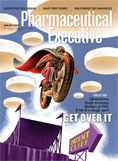Getting Across
Pharmaceutical Executive
It's just the way life works: You're always crossing the bridge before you get to it-or after it's gone
The cover of this month's Pharm Exec may look as if it's about disaster, but that's not the way we meant it. It's not about falling off a cliff; it's about crossing a bridge that extends from yesterday, and an old, failing way of doing things, to tomorrow, and a revitalized pursuit of new (still only dimly understood) goals. Admittedly, in our cover illustration the bridge is out. But the point is still to cross the gulf; the absence of a span just means you have to cross with a bit more energy. There's also plenty reason to expend thought and creativity on the subject of landing.

Patrick Clinton
Because that's what life and business are like. We're always crossing the next bridge before we come to it—or before it's been built or after it's fallen down. Those are the bridges that count, the ones that truly bring us from one place to another.
And that's what the pharmaceutical industry is doing today—getting to a new place. Much of this issue of Pharm Exec is devoted to exploring what that new place is going to look like. Two articles warrant particular attention in this light. Our annual forecast article, written again this year by senior editor Walter Armstrong, draws on insights from dozens of industry professionals, academics, and consultants, examining the ways in which politics and the current financial crisis will interact with pharma's own structural changes and circumstances in the first years of the Obama administration. In the world Walter portrays, there are almost too many potential drivers for action: an overstressed healthcare system, a disillusioned public, a president who knows he mustn't waste time in taking action, and a battered economy that will distort or even pre-empt the decision-making process. The trick will be getting a coherent strategy out of jittery, confused, and angry stakeholders.
Elsewhere, consultant Stan Bernard takes on what will arguably be the most distinctive feature of the new industry environment: competition. With payers using their purchasing power more aggressively, with the increasing ascendancy of generics, and with new demands for data on real-world comparative efficacy, pharma companies are going to be going head-to-head with each other in the next few years in ways they never have before.
The kind of competition Stan is talking about (and will be writing about quarterly in Pharm Exec this year) is not always pretty. Future articles will look at the specific tactics companies are already using to affect how competitors are perceived in the marketplace and pre-empt competitive claims. It's the sort of thing that—just like mirrored territories and giant sales forces and direct-to-consumer advertising—has a great potential benefit and a great potential downside. If fierce, head-to-head competition leads to greater clarity, greater understanding, and better outcomes for patients, it's going to be a good thing. If it turns out to be a way to manipulate patients, doctors, and payers, we'll soon be wondering how we ever got so far off track.
Here's what I take away from the Bush years: Market forces are incredibly powerful, but they can't be left to run things on their own. The grown-ups still have to run things. And the best thing the grown-ups can do is make market forces behave.
We don't even have to wait until we get to the other side of the bridge we're jumping.
Patrick Clinton
Editor-in-chief
Addressing Disparities in Psoriasis Trials: Takeda's Strategies for Inclusivity in Clinical Research
April 14th 2025LaShell Robinson, Head of Global Feasibility and Trial Equity at Takeda, speaks about the company's strategies to engage patients in underrepresented populations in its phase III psoriasis trials.
Beyond the Prescription: Pharma's Role in Digital Health Conversations
April 1st 2025Join us for an insightful conversation with Jennifer Harakal, Head of Regulatory Affairs at Canopy Life Sciences, as we unpack the evolving intersection of social media and healthcare decisions. Discover how pharmaceutical companies can navigate regulatory challenges while meaningfully engaging with consumers in digital spaces. Jennifer shares expert strategies for responsible marketing, working with influencers, and creating educational content that bridges the gap between patients and healthcare providers. A must-listen for pharma marketers looking to build trust and compliance in today's social media landscape.

.png&w=3840&q=75)

.png&w=3840&q=75)



.png&w=3840&q=75)



.png&w=3840&q=75)




















